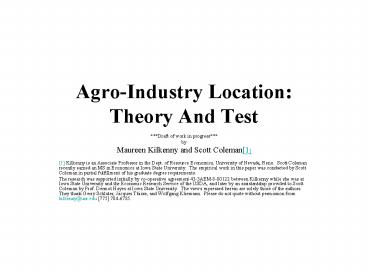AgroIndustry Location: Theory And Test PowerPoint PPT Presentation
1 / 24
Title: AgroIndustry Location: Theory And Test
1
Agro-Industry Location Theory And Test
- Draft of work in progress
- by
- Maureen Kilkenny and Scott Coleman1
- 1 Kilkenny is an Associate Professor in the
Dept. of Resource Economics, University of
Nevada, Reno. Scott Coleman recently earned an
MS in Economics at Iowa State University. The
empirical work in this paper was conducted by
Scott Coleman in partial fulfillment of his
graduate degree requirements. - The research was supported initially by
co-operative agreement 43-3AEM-8-80122 between
Kilkenny while she was at Iowa State University
and the Economic Research Service of the USDA,
and later by an assistantship provided to Scott
Coleman by Prof. Dermot Hayes at Iowa State
University. The views expressed herein are
solely those of the authors. They thank Gerry
Schluter, Jacques Thisse, and Wolfgang Kliemann.
Please do not quote without permission from
kilkenny_at_unr.edu 775 784-6785.
2
- Q Why do industries in which plants compete with
each other for inputs, - but not customers, neither fully disperse nor
concentrate spatially? - A Transport costs for shipping good
establishments that - employ ubiquitously supplied inputs
- whose opportunity cost declines with distance
from the market center - are strictly convex in distance.
- the Exclusion property/Endpoint optimality
doesnt hold - ? new model of agroindustrial location
- ? both the site and the extensive margins of an
establishment's input market area are endogenous - solution requires evaluating an integral with
respect to endogenous limits - first direct empirical test of establishment
location theory - unified theoretical rationale for concentration
or co-location (in cities or urban counties), or
dispersion (city, urban, or rural) - transport costs alone can give rise to all
three patterns
3
(No Transcript)
4
(No Transcript)
5
What do we already know?
- Canonical Location Theory
- Lederer and Hurter (1986), Hurter and Martinich
(1989) Facility Location and the Theory of
Production - Kilkenny and Thisse (1999)
- Choose single site with respect to von Thunen
inputs (island) Hsu (1997) - Normative (math programming) Optimal agriculture
processing plant location - across a set of material source and market
sink point locations on a network - the exclusion property (endpoint
optimality) is implicit - (1) math programming problems to determine the
optimal scales, numbers, and locations of
processing plants - King and Logan, 1964 Polopolos, 1965 Fuller,
Randolph and Klingman, 1976 - von Oppen and Scott, 1976 Kilmer, Spreen, and
Tilley 1983 - Dunham, Sexton, and Song, 1995 Kawaguchi,
Suzuki, and Kaiser, 1997 - (2) Social planner's problem where the objective
is to maximize producer plus consumer surplus - Takayama and Judge, 1964
- (3) points regions, given distances are between
geographic centers - Apland and Andersson, 1996
- Positive (econometrics) hypothesis testing
- Barkley and Henry (1998) locational Gini
coefficient is 0.15 (dispersed)
6
Agroindustry location
- a new general model
- industry point source inputs
- agroindustry ubiquitous inputs
- Q1. Where does the first establishment optimally
locate? - In the middle of input supply region
- And these central and accessible places became
cities! - Q2. Where do subsequent plants optimally locate?
- (i) at the same market site
- concentrate
- metro or urban counties
- (ii) within the same supply region
- co-locate
- urban counties
- (iii) patronize a new supply region or serve a
new market - disperse
- metro, urban or rural counties
7
0
N
locations m (mile), f (farm), s
(establishments site)
8
- Q1. Where would the first plant locate?
- opportunity cost P , purchase price Pc
- Farmers at f transport corn to a processor at s
- input transport cost rate t per unit product
and distance - Pc - tf-s P
- Processor at s fixed cost of plant K,
- marginal cost c (q IO1, QN)
- input price Pc,
- output transport cost rate T,
- mill price PM Ts-m PD
- Farmer-consumers at m each demand one unit at the
delivered price, PD. - Profits at site s PDN K - cN - PcN -
9
(No Transcript)
10
(No Transcript)
11
(No Transcript)
12
p tx
p tx - 2tf
t(f - x)
t(x - f)
t(f - x)
p - tx
-d
d N/2
2d N
Figure 2. Input price schedules with respect to
distance
13
p tx
p tx - 2tf
t(f - x)
t(x - f)
t(f - x)
p - tx
-d
d N/2
2d N
three domains concentrated,
co-located dispersed
14
(No Transcript)
15
(No Transcript)
16
Figure 3. Costs (PROFITS) are strictly convex
(CONCAVE) in distance
17
the empirical model
X aZ ßW ?
18
Figure 5. Establishing unique
plant pairs
19
(No Transcript)
20
(No Transcript)
21
(No Transcript)
22
(No Transcript)
23
(No Transcript)
24
(No Transcript)

